5 Best Creative Intelligence Tools for DTC Brands in 2025
Your ad creative determines campaign success. Short videos and simple designs can differentiate high-ROAS winners from wasted tests. If viewers don’t stay past the first few seconds, most of your message isn’t received.
Many teams guess which visuals, hooks, or headlines work, which can raise CPA but slow user acquisition and lead to last-minute fixes. New AI tools analyze images, videos, copy, and audio to link creative signals to installs, purchases, and ROAS, enabling data-driven decisions.
Creative intelligence tools for DTC brands turn raw ad assets into clear answers. They tag creative elements at scale, identify repeatable patterns in winners, and surface forecasts or alerts to enable teams to quickly reallocate budget to the best assets.
In this blog, we'll pick five top creative intelligence tools for DTC brands in 2025, show what each tool does for user acquisition and ROAS, and give a short checklist to select and pilot the right one for your team.
What Are Creative Intelligence Tools?
Platforms or software that combine creative know-how, data, and machine learning/AI to evaluate, score, generate, and optimize ad creatives (static, video, copy, etc.). They tie creative performance directly to business metrics (such as ROAS, CAC, and lifetime value), not just engagement or reach.
Why DTC Brands Use Them
Direct-to-consumer brands rely on ad creative to drive acquisition and maintain healthy unit economics. Creative intelligence transforms asset-level performance into clear, repeatable guidance, which helps reduce wasted ad spend, refresh creatives before they fatigue, and increase return on ad spend (ROAS).
Independent research and industry platforms indicate that creativity is a top driver of marketing effectiveness and is often underutilized.
How These Tools Work
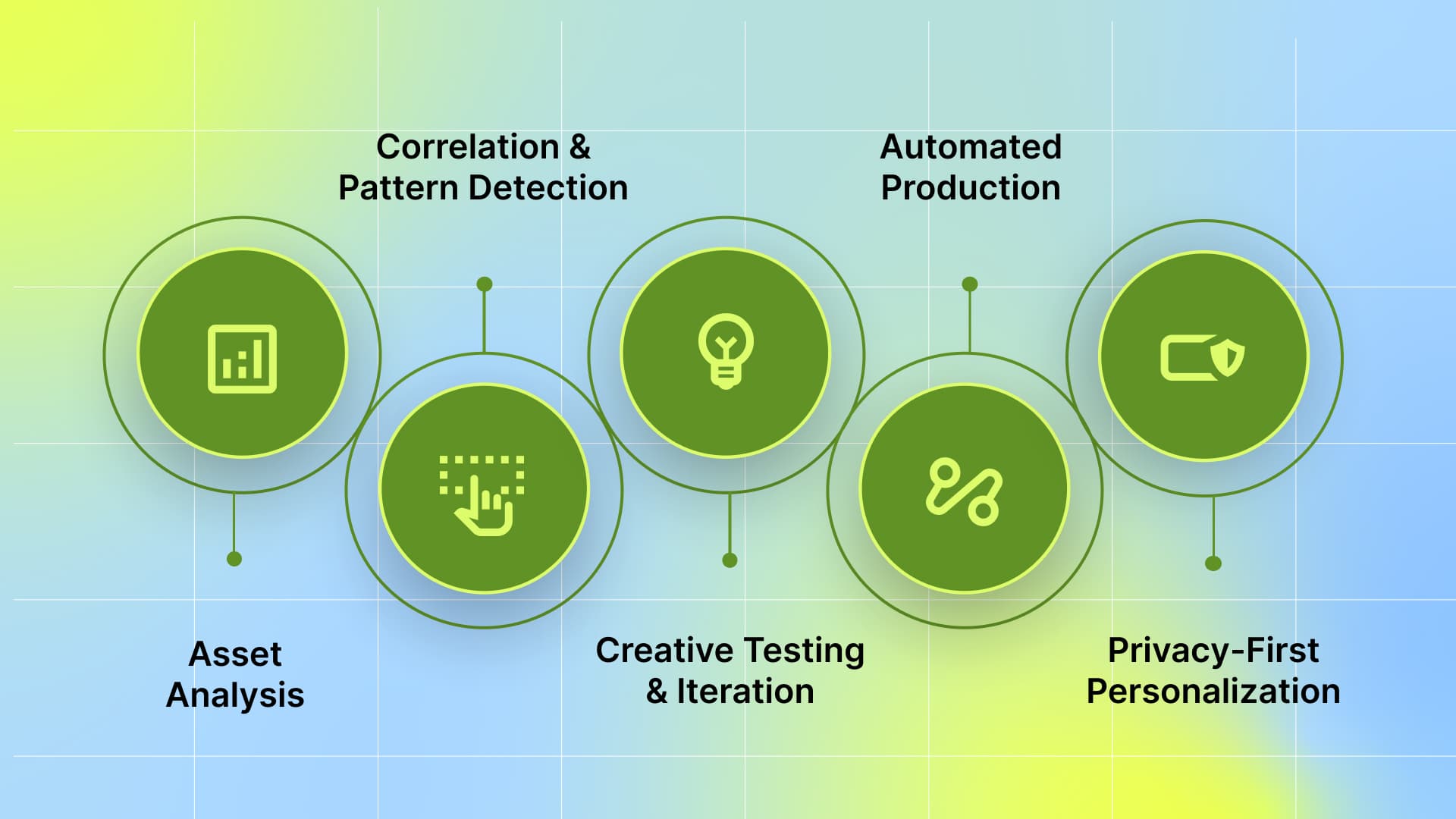
Asset Analysis: Break ads into elements (visuals, headline, CTA, duration, people, product shots) and score each against performance.
Correlation & Pattern Detection: Link specific elements with outcomes (CTR, CVR, ROAS) to understand what actually drives results.
Creative Testing & Iteration: Automate A/B tests or multi-variant tests and recommend which variants to scale.
Automated Production & Templates: Generate many on-brand variations (short-form videos, static ads) to support rapid experimentation.
Privacy-First Personalization: Enable creative customization without relying on third-party cookies, aligning with modern platform requirements.
Why They Matter in 2025
Ad platforms and consumer expectations are shifting fast. Segwise’s Winning Creative Patterns in DTC report shows that ads featuring people perform 9x better than those showing only products. The best ads typically last 20 to 30 seconds, and 75% of top performers hook viewers within the first 3 to 4 seconds. Ads that highlight benefits dominate, appearing in 72% of top ads, while problem-focused ads are less common, at under 40%.
These patterns prove that a handful of creative choices can make or break results. Creative intelligence tools help you detect these trends in your own ads, cut wasted spend on underperforming formats, and double down on the styles that consistently drive revenue.
So what does this mean for DTC brand teams specifically? Here’s a breakdown of the key benefits these tools offer for your brand’s growth.
Also Read: Creative Optimization in 2025: Actionable Insights Report
How Do Creative Intelligence Tools Help DTC Brands?
Here’s how these tools support teams in 2025:
Spot high-performing creatives and headlines fast by turning ad elements into measurable signals.
Lower CPA by shifting budget to assets that show real conversion and revenue impact.
Create quick feedback loops between marketing, design, and performance teams.
Merge creative tags with attribution and revenue data to tie ad decisions directly to sales and ROAS.
By replacing guesswork with clear, testable insights, these tools enable teams to find winners faster and spend their media more efficiently.
Top 5 Creative Intelligence Tools for DTC Brands in 2025
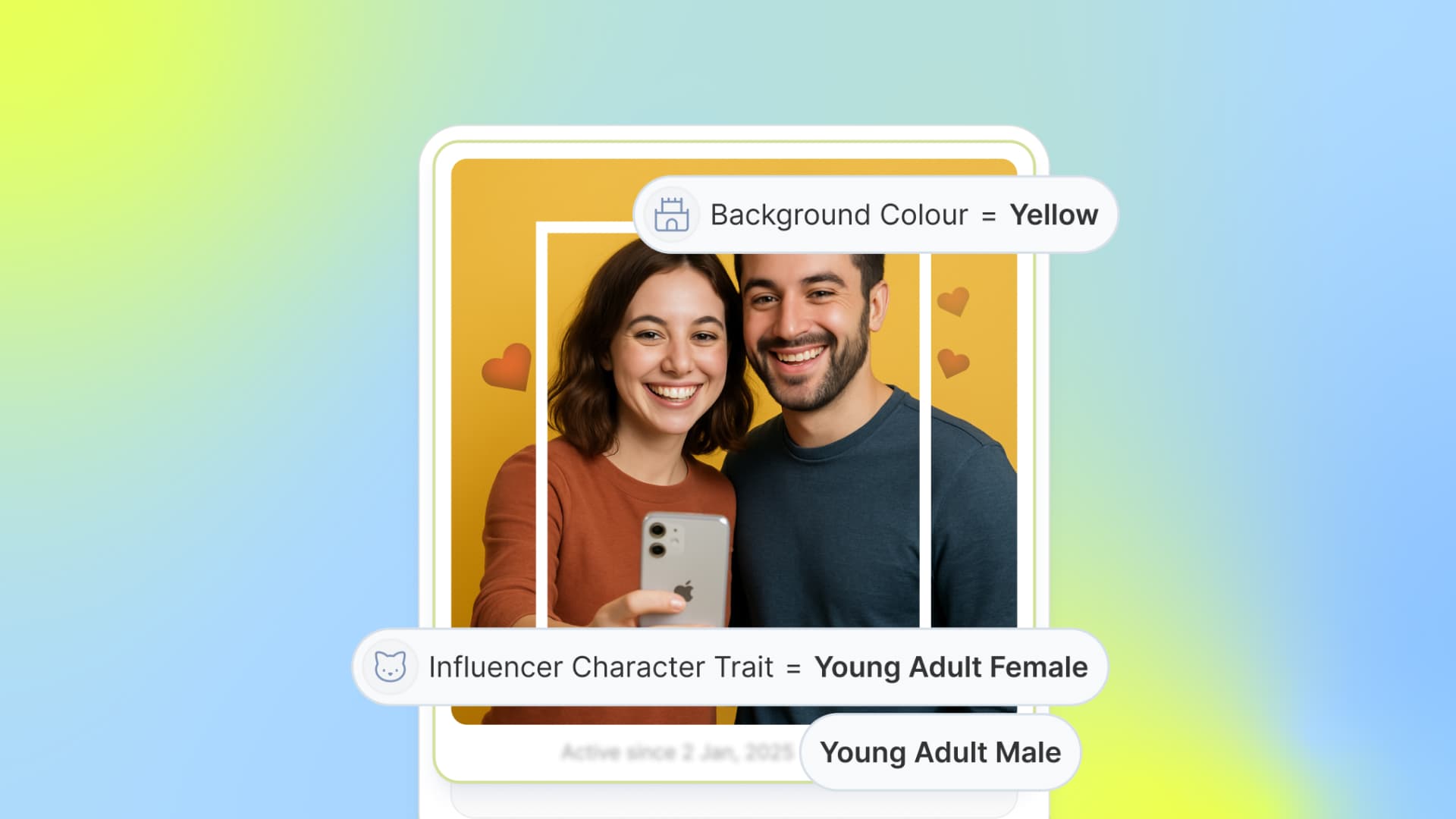
The list below highlights five tools, with each entry providing a concise overview, key features, practical benefits for DTC brand teams, and a brief explanation of why the tool is a top choice for 2025.
1. Segwise
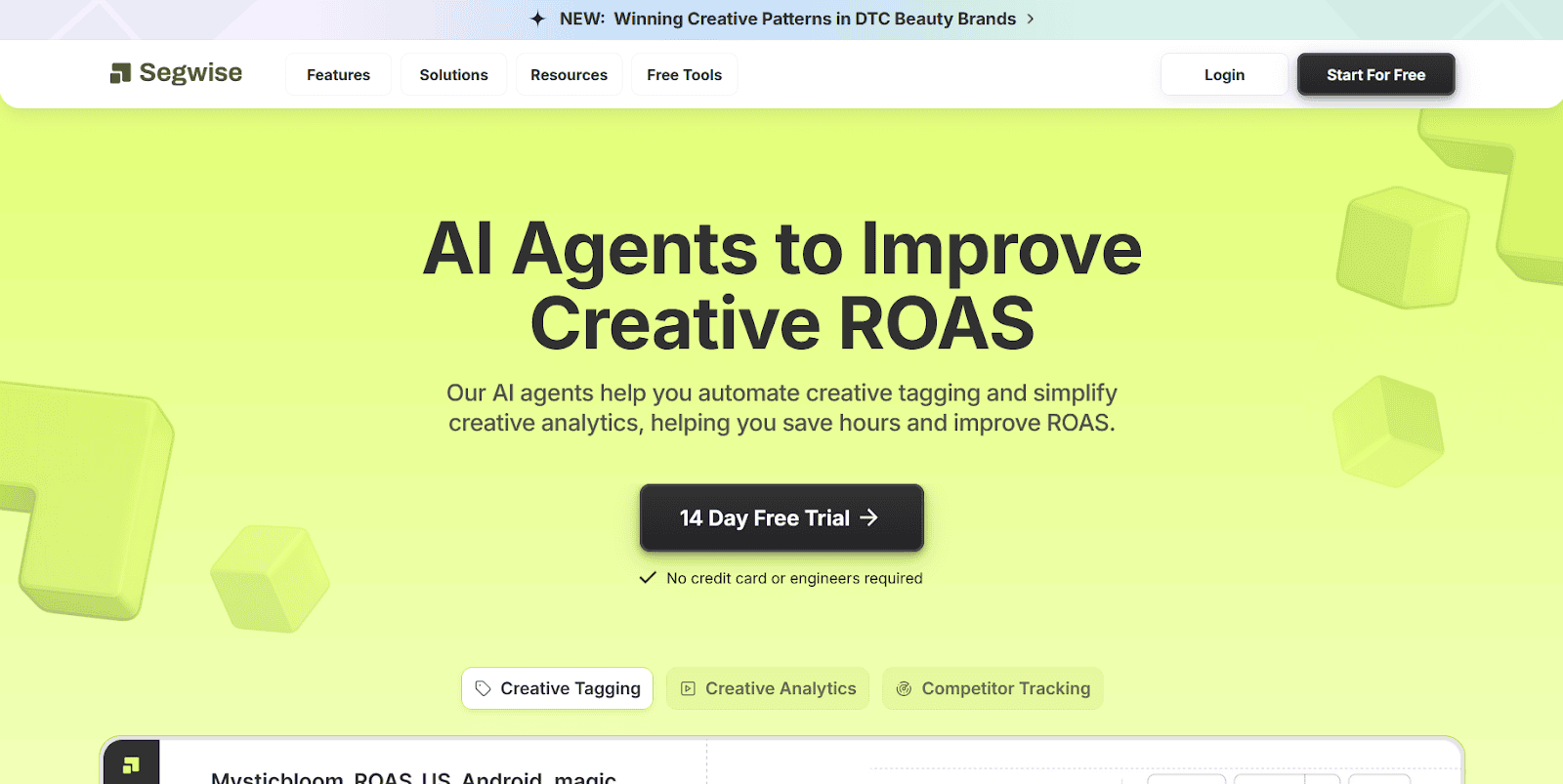
Segwise uses multimodal AI agents to automatically tag visual, text, and audio elements inside ads, then links those tags to campaign metrics like installs, CPI, and ROAS. The product includes integration guides for common mobile measurement partners and ad platforms, enabling the combination of creative signals with performance data.
Key features
Multimodal creative tagging (visual objects, text lines, audio cues, CTAs) with custom tag support.
Cross-platform creative analytics that merges ad network data and MMP metrics into a single view.
Prebuilt integrations with all major ad networks and mobile measurement platforms to speed setup.
How it helps DTC brand teams
Segwise turns creative elements into measurable signals, allowing teams to see which visuals, voice lines, or text snippets correlate with installs and purchase events. This saves manual tagging work, helps mobile UA teams reproduce winning creative patterns, and provides early alerts when a creative stops performing. The integrations with MMP or other backend data systems make it practical for teams already measuring installs and ROAS to add creative-level diagnostics without heavy engineering.
Why it’s best
Segwise is a strong pick when ad creative needs to be linked tightly to performance metrics. For mobile-first DTC brands that rely on MMP metrics, Segwise’s multimodal tagging features are built to connect asset-level signals directly to outcomes. This focus enables small performance teams to identify winning creative patterns and resolve underperforming ads more efficiently.
2. Smartly.io
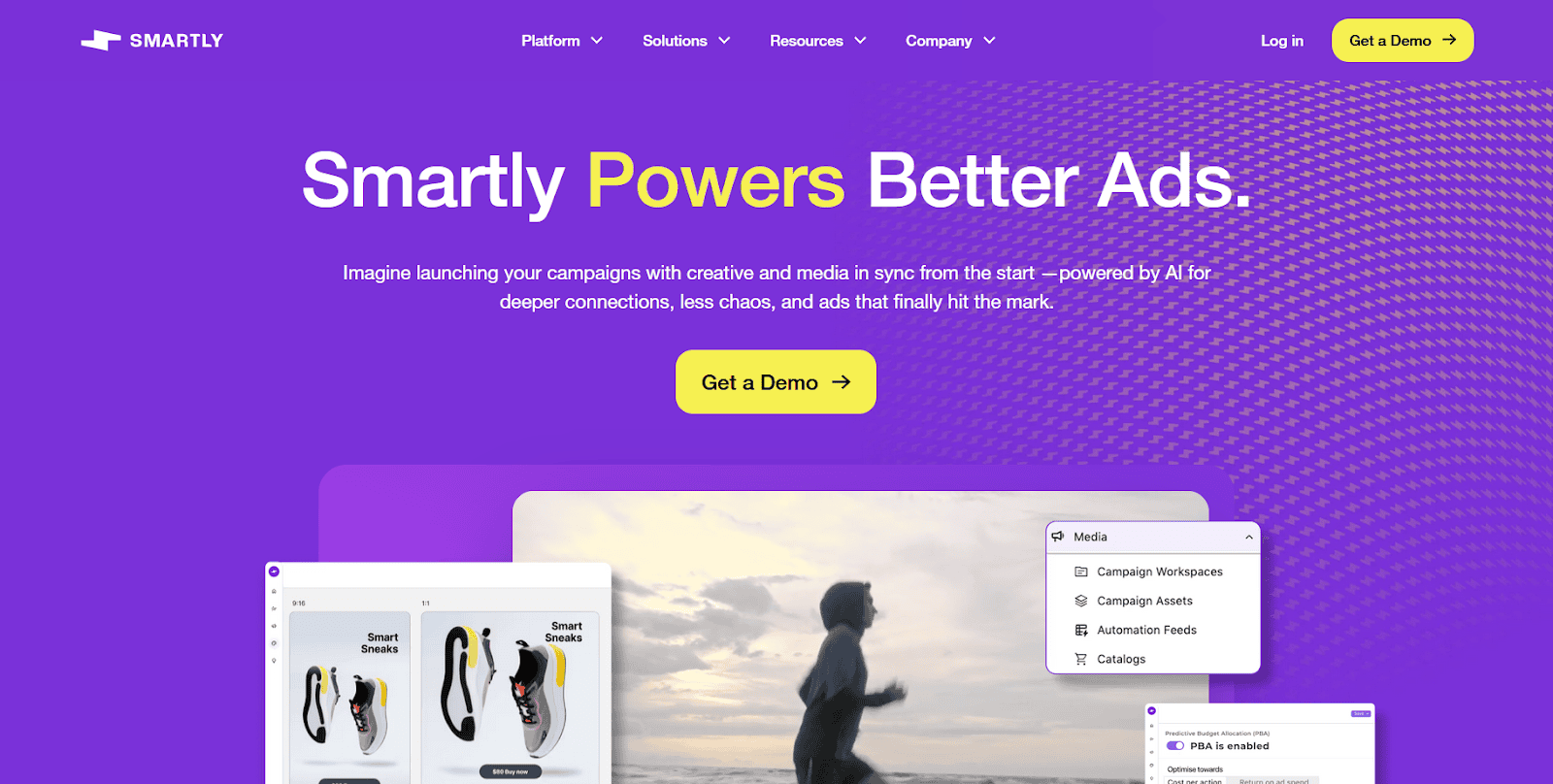
Smartly.io is a cross-channel ad platform that combines creative production, templating, automation, and asset-level performance metadata. It is used to create multi-format ads, run large-scale creative tests, and deliver assets to channels like Meta and TikTok from one place. The docs describe creative assembly features and a Creative Suite built for teams that must produce many ad variants.
Key features
Creative design and templating to produce many sizes and formats quickly (static, video, dynamic).
Video Ad Assembly and other AI-assisted production tools for fast video generation.
Asset-level creative metadata and performance reporting for optimization.
Collaboration workflows for creative approvals and in-flight tweaks.
How it helps DTC teams
Smartly.io accelerates ad production and maintains design consistency across various sizes and channels. Creative and media teams can share the same assets, test templates at scale, and use the platform’s reporting to see which creative variants and templates move conversion metrics. This reduces manual resizing, cuts production bottlenecks, and helps maintain brand consistency while launching many experiments.
Why it’s best
Smartly.io is best suited for scenarios where the priority is scaled production and channel delivery. For DTC brands that run high-volume campaigns on social platforms, Smartly’s templating, video assembly, and asset-level reporting let teams produce and iterate at the speed required for large seasonal pushes or heavy ad testing. It suits organizations that require both creative control and ad ops scale within a single tool.
3. Pencil AI
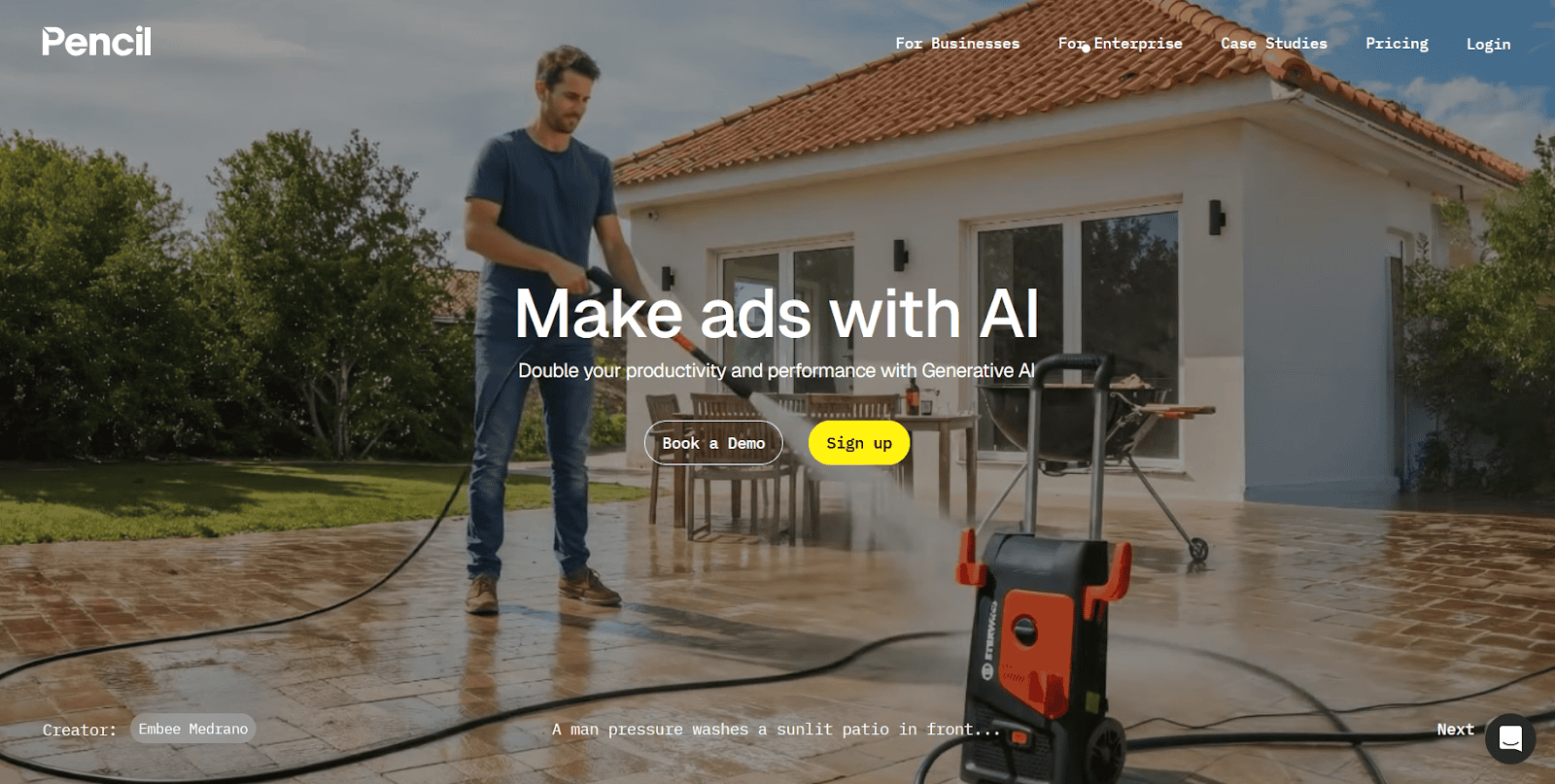
Pencil is a generative AI ad platform that creates ad variations and predicts likely performance using models trained on campaign history. The platform offers integrations with design tools, has released AI “agents” for iterative creative workflows, and is positioned for marketers who want faster variant generation with performance forecasts.
Key features
Generative ad creation across text, image, and short video can produce many variants quickly.
Performance forecasting that ranks or predicts which variants are likely to perform best.
Integrations with Figma, Photoshop, Runway Gen4, and marketplace availability for enterprise access.
AI agents for iterative idea generation and automated copy/voiceover options.
How it helps DTC teams
Pencil reduces the time needed to produce testable creative sets. Growth teams and agencies can use the platform to generate more variants, run broader A/B tests, and prioritize the highest-predicted performers before spending media budget. The design tool integrations enable existing design workflows to remain intact while introducing automated generation and forecasting capabilities.
Why it’s best
Pencil is a good match when creative throughput and quick hypothesis testing matter most. For subscription apps or DTC brands that need numerous on-message ad variants quickly, Pencil’s generation and performance forecasting help launch more experiments with fewer design hours. That speed-to-test approach can reduce time wasted on low-potential assets.
4. Pixis
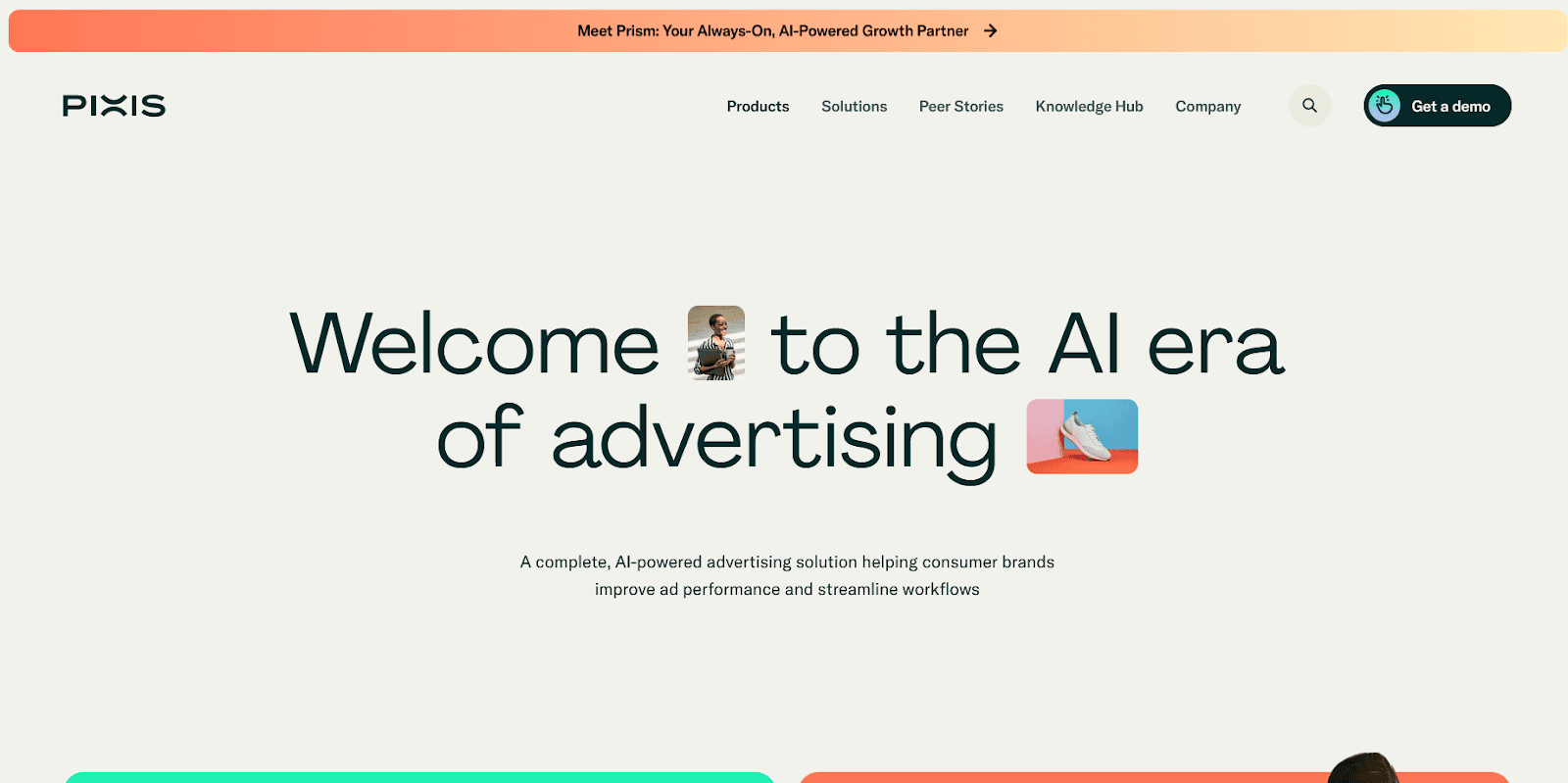
Pixis is an AI-driven ad platform that focuses on end-to-end creative generation and campaign execution for consumer brands. Its Adroom product generates on-brand visuals and copy at scale, pairing creative generation with automated media buying and optimization in the Pixis stack. The company highlights brand alignment, speed, and performance-driven creative generation.
Key features:
Adroom: on-brand generative creative studio that produces ready-to-run assets (static, video, dynamic).
Brand governance: assets follow supplied brand fonts, colors, and tone so generated creative stays consistent.
Integration with automated media buying (the Pixis Advance loop) so tests and winners can scale quickly.
Content intelligence for audience-driven personalization and recommendations.
How it helps DTC teams
Pixis helps teams reduce the production drag that slows tests. Marketers can create many on-brand variants in seconds, run tests, and let the platform route higher-performing creatives into scaled buys. The brand controls and governance features enable small creative teams to maintain brand standards without a large approval backlog. Pixis also provides guides and benchmarks for common retail categories, which help set realistic expectations for planning.
Why it’s best
Pixis is a strong option when brand consistency and an integrated creative-to-buy loop matter. For DTC brands running frequent catalog-style campaigns or seasonal drops, Pixis’s Adroom, combined with automated buying, helps scale winning creative assets faster while keeping them on-brand. The platform’s focus on practical templates and campaign playbooks is beneficial for teams that seek a balance between speed and governance.
5. VidMob (Creative Analytics)
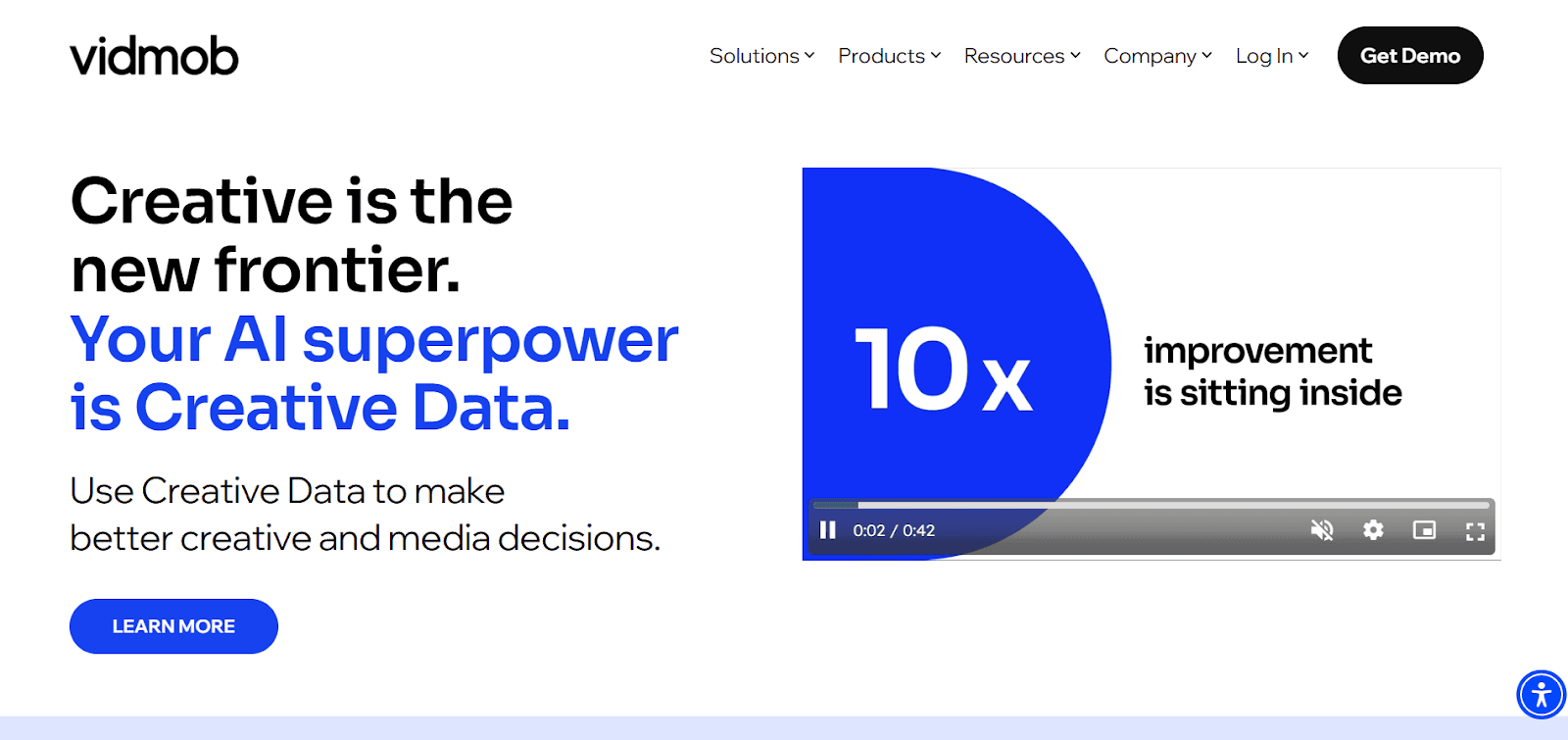
VidMob is a creative data platform that utilizes AI to tag and score visual and audio elements, link creative variants to performance, and deliver creative recommendations within the same measurement stack used by media teams.
Key features:
Automated, frame-by-frame visual and audio element detection (objects, text, logos, scenes) for large creative libraries.
Creative scoring and predictive quality metrics that estimate which assets will perform before full flight.
Connectors to ad accounts and exports/APIs, allowing creative signals to be joined with spend, conversions, and MMM inputs.
Brand-compliance checks and pre-flight guidance (plugins and workflows to score assets during production).
Data exports and reporting for measurement teams (Creative Data API, case studies showing integration with MMM and performance platforms).
How it helps DTC teams
DTC brands can use VidMob to find which creative elements actually move purchase behavior and ROAS, not just engagement. By tagging thousands of variants and integrating that layer with ad spend and conversions, teams can quickly reallocate budget toward formats, hooks, and visuals that drive revenue while weeding out attractive but unprofitable assets. VidMob’s scoring also speeds up iteration by flagging low-probability concepts before heavy media spend.
Why It’s Best
VidMob is widely adopted across brand and agency teams, and, according to industry evaluations, has been recognized for its creative ad-tech capabilities, making it a mainstream option for marketers who want creative signals within their measurement stack. Recent case work and partnerships demonstrate its use in feeding creative quality into MMM and programmatic decision-making.
Select a platform that aligns with your team size, campaign objectives, and data needs to transform creative testing into a reliable method for boosting ROAS in 2025.
After reviewing the top tools, the next step is to know how to select the right one for your team’s goals and setup.
Also Read: Top Creative Optimization Tools You Need in 2025
How to Choose the Right Creative Intelligence Tool
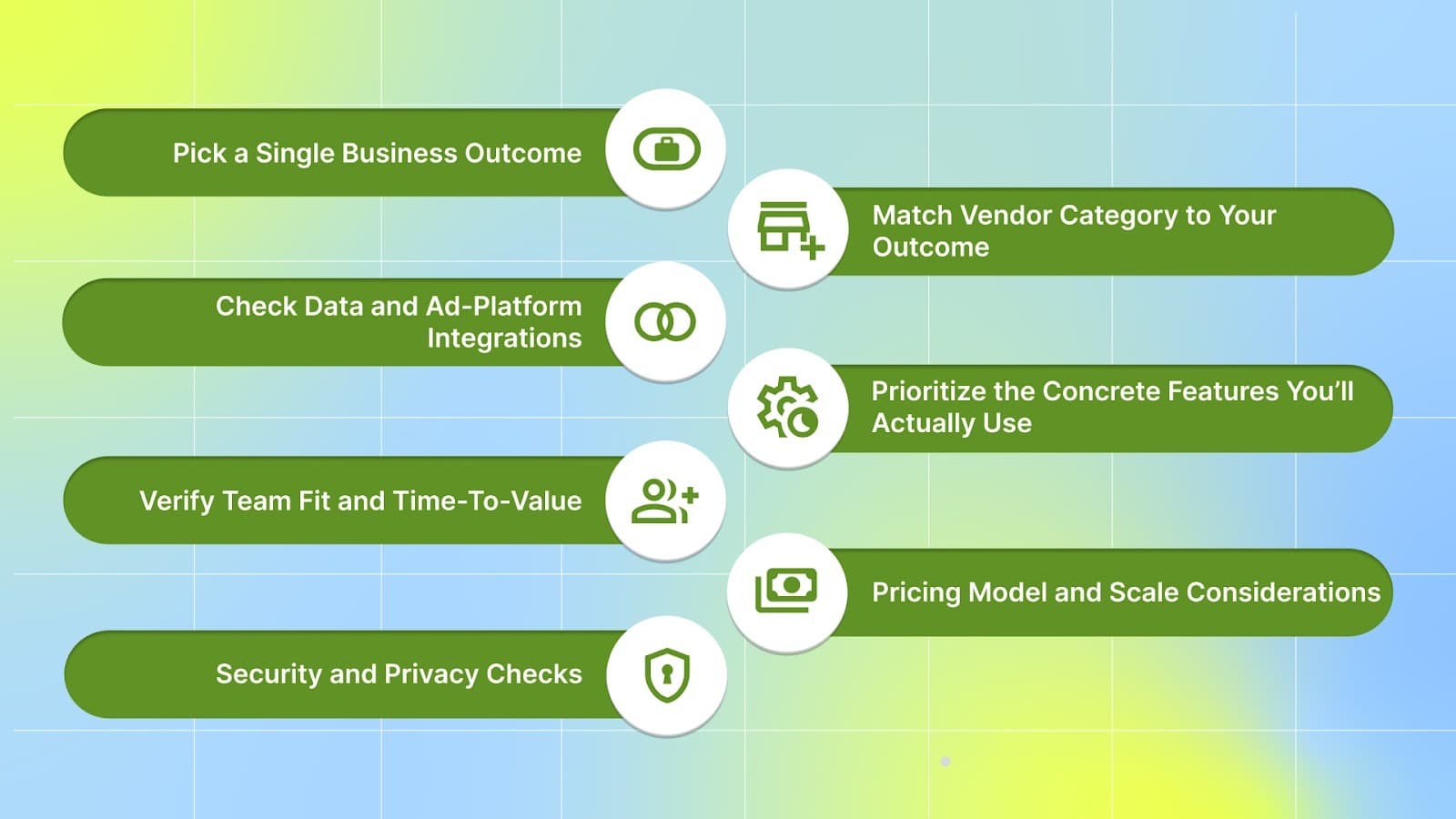
Start with one clear goal for the tool (ideation, performance analysis, forecasting, or automation). That single choice will shape which features and integrations matter most.
1. Pick a Single Business Outcome
Decide which outcome will move your unit economics: generate on-brand variants, identify which creative elements drive conversions, forecast winners before you spend, or automate production and testing. Each outcome maps to different vendor strengths (creative-scoring platforms vs. generative/templating platforms vs. production/ops vendors).
2. Match Vendor Category to Your Outcome
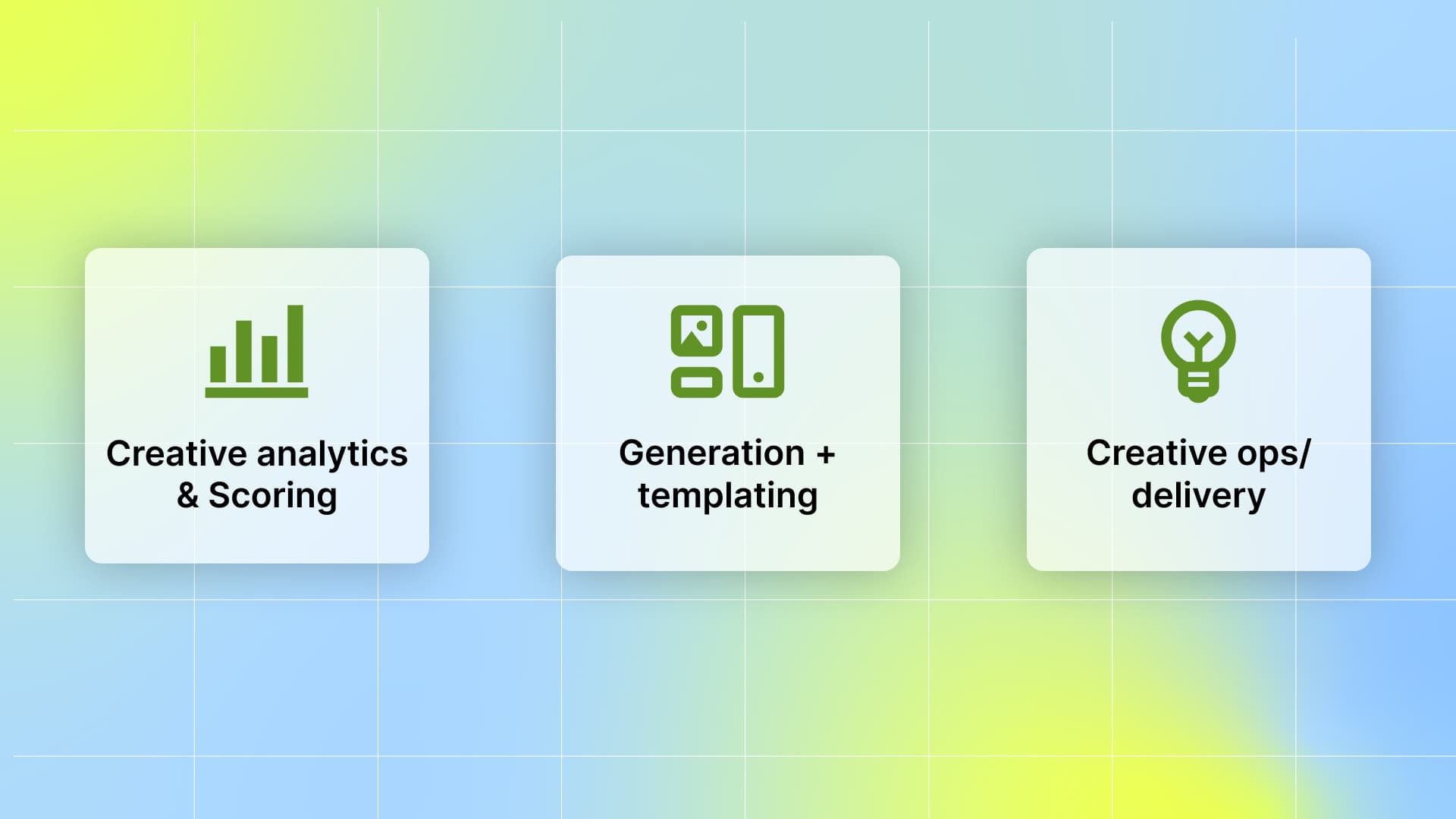
Creative analytics & scoring: extracts elements, scores creative, shows element-to-performance correlations (best when you need diagnosis and learning).
Generation + templating: produces many on-brand variants quickly (useful when scaling tests across placements).
Creative ops/delivery: builds, localizes, and publishes assets across placements and sizes.
3. Check Data and Ad-Platform Integrations
You want a tool that ingests raw, ad-level data and links creative IDs to outcomes (such as clicks, installs, or purchases) rather than relying on manual exports. Confirm direct connectors for Meta, TikTok, Google Ads, and your attribution partner or DSP. Cross-platform visibility is key for transferring winning creative from one channel to another.
4. Prioritize the Concrete Features You’ll Actually Use
Score vendors against this short checklist:
Automated asset parsing and element-level tagging (visuals, hook, CTA, scenes).
Statistical linkage between elements and outcomes (CTR, CVR, ROAS).
Exports & APIs (CSV, BI connectors, tag/score export into ad workflow).
Test orchestration or variants push (ability to create or push winners into ad accounts).
Prediction models (for pre-launch idea ranking).
5. Verify Team Fit and Time-To-Value
Ask how the vendor’s output will land inside your existing process. Will tags be included in the ad naming convention? Can media and analytics teams consume reports without manual work? Prefer vendors that offer a short pilot and provide deliverables that you can act on the same week (tagged exports, ranked creative list, or test-ready variants).
6. Pricing Model and Scale Considerations
Look past headline pricing. Confirm what drives costs: ad spend brackets, data volume, seat count, API calls, or templates produced. For small ad programs, start with a pilot or lean plan; for scaled UA, pick vendors that support cross-platform reporting and attribution integration.
7. Security and Privacy Checks
Request SOC 2 (Type II preferred), the vendor’s privacy policy and sub-processor list, and any region-specific compliance notes (GDPR, data transfer frameworks). These items matter for partnerships with MMPs and ad platforms.
Use a short pilot that measures one or two KPIs (CPA, ROAS, or conversion lift). During the pilot check, data connections are functioning, the output format meets the team's requirements, the vendor can demonstrate creative-to-outcome links, and security checks are passing. If the pilot shows clear signals and clean exports, scale the tool by the ad budget and the number of teams that need access.
Also Read: Creative Tagging Tools That Can Boost Your Ad Campaign ROI in 2025
Conclusion
In 2025, creative intelligence tools are essential for DTC brands, helping optimize ad performance and maximize ROAS. They transform creative elements into actionable insights, eliminating guesswork and enabling teams to focus on effective strategies. The right creative intelligence tool should link ad elements directly to results, such as CPA, ROAS, or conversions, making insights actionable.
Segwise simplifies this by tagging visuals, text, and audio, and connecting those signals to campaign data. This helps you identify what drives installs or sales, set performance alerts, and guide your team on next steps.
Start a 14-day free trial and see the impact firsthand.
FAQs
1. Which KPIs should DTC teams use to judge a creative-intelligence tool?
Track ROAS, CPA/CPI, conversion rate (CVR), and creative-level CTR, as well as any predicted lift or quality score the vendor provides. Then, map these metrics to revenue or LTV so that creative signals are linked to business outcomes.
2. How long should a pilot run to produce reliable signals?
Run a focused 30-day (≈4-week) pilot on a single channel or campaign to gather enough impressions and conversions for stable signals; measure time-to-value (TTV) during onboarding so you know when results are actionable.
3. What integrations and data inputs do these tools need?
Expect connectors to ad platforms (Meta, TikTok, Google), your attribution/MMP, and BI/export endpoints so creative IDs can be joined with spend and conversion data for element-to-outcome analysis.
4. How do vendors handle data security and privacy?
Look for public controls (SOC 2 Type II, ISO 27001), GDPR/CCPA compliance statements, and clear data-processing agreements. Many leading vendors publish compliance documents and SOC/ISO status reports.
5. What pricing models should DTC brands expect?
Generative/production tools often use tiered self-serve plans (monthly credits or generations). Creative analytics platforms commonly use custom/enterprise pricing based on data volume, seats, or integrations, starting with a small paid plan or demo to validate ROI.

Comments
Your comment has been submitted successfully!